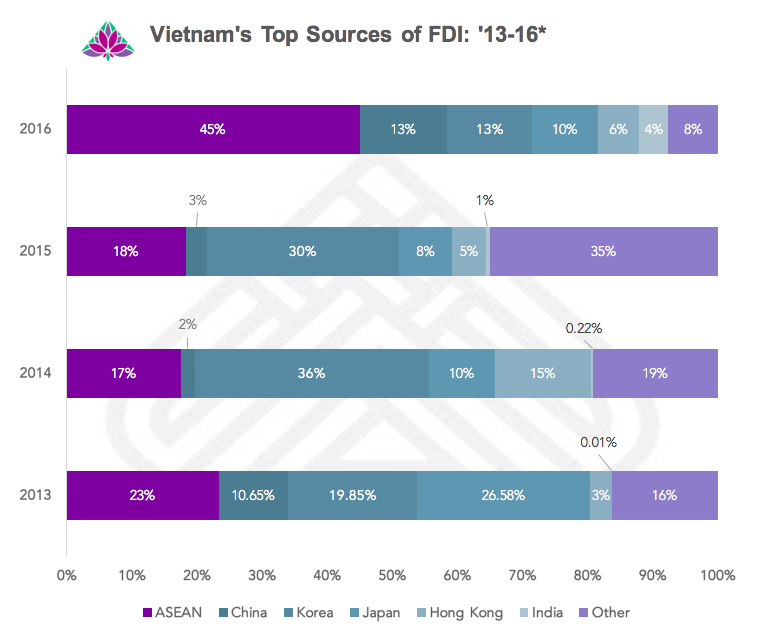Vietnam’s rapid pace of integration into global commerce is likely to yield unparalleled opportunities and record foreign investment in the near to medium term. While speculation on the nature of Vietnamese FDI has been on the rise, the availability of credible data remains scarce.
To help investors make informed decisions about existing opportunities and likely competitors, the following article outlines key findings from some of the first FDI data released by the Vietnamese Ministry of Planning and Investment since the passage of TPP, Implementation of the ASEAN Economic Community, and signing of Vietnam’s FTA with the European Union. Published at the end of January, 2016, this data provides insight on sources, destinations, industries, and vehicles of foreign direct investment. Should any questions arise as a result of this presentation, do not hesitate to contact members of our staff at vietnam@dezshira.com or www.dezshira.com.
Vietnamese FDI: The Outlook in 2016
Initial figures from January’s FDI data show strong year on year growth over 2015. Newly registered projects reached a high of 127, up 186 percent from a year prior. Total FDI from this period was also up over 100 percent – exceeding 1.3 billion dollars. The substantial changes over 2015 help to highlight the increased importance of Vietnam as a destination for foreign capital and underscore the utility of these figures as a means to evaluate the communist nation’s changing reception as an investment destination by potential investors.
Sources of Investment
The Rise of ASEAN
With regard to sourcing, the most notable feature of 2016’s investments lie in the uptake of capital flows originating within ASEAN. Although Vietnam is a choice destination for all within the economic bloc, based on the Vietnamese economy’s low production costs, key investors to watch within the AEC are Malaysia and Singapore – accounting for 18 and 22 percent of Vietnamese FDI respectively.
Party to the TPP and ASEAN simultaneously, companies based in these two countries are able to tap into the combination of Vietnam’s competitive production costs and lowered trade barriers, in conjunction with the predictable government treatment and lucrative tax arrangements found within their respective home markets.
Appetite for investment in Singapore and Malaysia, however, contrast sharply with that of traditional investors within the region such as China, Hong Kong, and Korea – which have seen declines in recent years. Hong Kong – the traditional hub for holding corporations – can be seen to be slowing in relation to Singapore’s more prominent position as a hub for ASEAN investment.

* Based on FDI as of January 2016
Future Growth: The EU and India
While constituting a small porition of FDI within Vietnam, both India and the EU will likely become increasingly important investors in Vietnam evidenced by strong growth in recent years. Companies based in India have been exponentially increasing investments over the past three years reaching a 4 percent share of FDI as of January 2016 – up 400 percent over last years average. Driving these investment have been increased cooperation on issues of security as well as complimentary production in of goods such as textiles and pharmaceuticals.
The EU, with its recent conclusion of an FTA with Vietnam, is well positioned to tap into the Vietnam’s potential. Although current FDI figures likely reflect a wait and see attitude with regard to commitments of capital, the passage of the EU-VN FTA will likely spark an uptake in investment flows. Key investors to watch in this regard include large and profitable economies within the EU such as Germany, as well as Southern producers in Spain and Italy seeking to adjust production to accommodate declines in purchasing power seen since the start of the debt crisis.
Destinations for Investment
Main Cities
As in previous years, investment continues to be drawn to major cities within Vietnam such as Hanoi and Ho Chi Minh City. Investors within these localities generally benefit from improved access to infrastructure as well as the advantages of agglomeration – stemming from the concentration of talent and resources in areas with more foreign operations.
By: Dezan Shira & Associates
Editor: Maxfield Brown